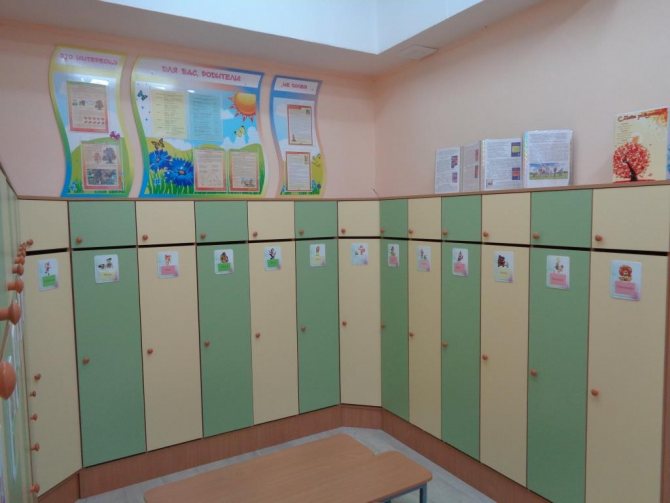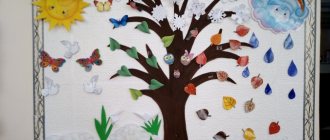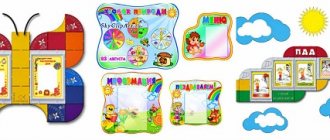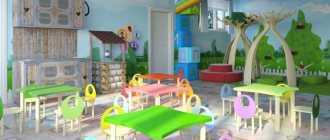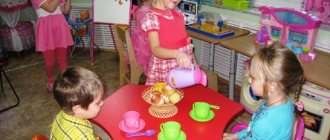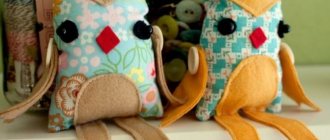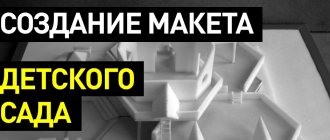“Transformability of space in kindergarten”
Transformability of space in kindergarten
Transformability of space -
the possibility of changing the subject-spatial environment depending on the educational situation, including the changing interests and capabilities of children.
When organizing direct educational activities, you need to use mobile material, which is constantly varied and modified, which allows you to enrich the plots of games and diversify the educational space of the group. Objects and toys with which a child acts are not just objects of his attention, but means of communication with adults and children.
The principle of transformability of the environment in groups is implemented through variability depending on the age characteristics of children, the period of study, and the educational program being implemented.
Transformability principle
1. It is necessary to have lightweight structures
, modules, screens, tents, light benches, modular furniture, curtains and other devices that can be easily changed functionally. For example: the teacher pulled back the curtain, and then closed the topic of the project with clarity - and this visual material does not prevent the children from concentrating on designing, and children can easily design the same curtain as a “billboard” for their activities or use it for an exhibition of their works). These same designs will allow children to independently arrange the space at their own discretion, to choose, equip or inhabit it at their own discretion, to build their own little world. This is especially true for imaginative play. The possibility of transforming space, including that performed by children, can also be realized through the use of sliding (and unrolling roller) partitions.
2. Furniture height
in kindergarten it should be easy
to change.
You need to get away from:
- Wall decoration and decorative elements should be changeable and understandable to preschoolers;
- fixed front arrangement of tables and chairs;
- stationary placement of gaming corners for story games with fixed themes and plots (“Kitchen”, “Hospital”, “Shop”, “Hairdresser”. The content of the gaming corner should be more mobile and regularly updated.
The construction of a subject environment is the external conditions of the pedagogical process that make it possible to organize the child’s independent activity, aimed at his self-development under the supervision of an adult. It is important that the subject environment has the character of an open, non-closed system, capable of change, adjustment and development. In other words, the environment is not only developing, but also developing. Practice suggests that it is difficult to completely replace the subject environment in a group. But still, under any circumstances, the objective world surrounding the child must be replenished and updated. Only then does the environment contribute to the formation of cognitive, speech, motor and creative activity.
The environment should provide light, movable, portable structures that enable children to create space for play in a convenient place - platforms on wheels, small podiums on wheels, portable playground corners made of a plastic base, which can also serve as screens.
The idea of mobility and dynamism can be easily realized with the help of a screen. It allows children to escape from the world of adults and settle in their own “nest”.
Transformable screens have been made for games: (steamboat, car, military vehicle, girls' room), which allows you to use gaming equipment in different ways. Screens have two and three doors, they are light and safe to use.
The “Machine” screen can serve as a plot for games and allows the child to limit his play area. The wheels and awning of the machine are removable, which makes it easy to store the screen.
The “Boat” screen for boys can have an angular shape. A child can upgrade it with the help of attached paraphernalia, and marine-themed items (anchor, steering wheel, lifebuoy) will help quickly organize the game.
It is enough to replace the fabric covering and it is no longer a ship, but a military vehicle or a headquarters for commanders. Children can act on their own depending on the game plan. Screens for boys allow you to change the subject-spatial environment and introduce new things into it in accordance with the interests of the children. All the boys' favorite items can be easily attached and placed in their pockets: watch, walkie-talkie, flashlight, map, binoculars. They also easily accommodate carpentry and joinery tools: a hacksaw, a hammer, a screwdriver. And the flirtatiously elegant screen for girls seems to emphasize the serious nature of the boy’s screen.
Screen for girls can
made of a light veil, which is gathered so that it resembles the shape of a light airy skirt. The screen is complemented with attributes for a little lady (chest, hat, beads, umbrella).
The screens are convenient to store and easy to fold, allowing you to carry them. Screens are multifunctional and versatile.
Soft modules enrich children's play and provide transformability and multifunctionality of the play space. At the discretion of the players, it can be a rocket, a swimming pool, a palace, a bus, etc.
The fullness of the subject-developmental environment allows children to experience an event each time in a new situation, environment, which develops fantasy and imagination, allows them to master the means of communication and ways of interacting with adults and peers.
Making the playing field:
“Forest glade”, equipped with a set of small toys that can be used in different settings (farm, village, park, etc.), in accordance with the children’s play plans. Children can add ready-made models or build the necessary structures from various construction sets, use substitute objects, and homemade toys.
“The Road” helps to consolidate and embody children’s personal social experience in the game, immersion in the game situation, showing ingenuity in using the subject environment, performing a variety of game actions, and complementing the game environment as the game progresses.
PROJECT “TO CREATE A TRANSFORMABLE SUBJECT-DEVELOPMENT ENVIRONMENT IN A PREPARATORY GROUP.”
Municipal budgetary preschool educational institution "Kindergarten No. 49"
PROJECT
“TO CREATE A TRANSFORMABLE SUBJECT-DEVELOPMENT ENVIRONMENT IN A PREPARATORY GROUP.”
Developed by:
Druzhinina Elena Alexandrovna
Berezniki, 2017
1
.Relevance of the project: The problem of the RPPS group does not fully meet the requirements of the Federal State Educational Standard for Educational Education, and does not fully realize the educational potential of the group space.
To create a subject-development environment that is adequate to the program being implemented, corresponding to the characteristics of the pedagogical process and the creative nature of the child’s activity, this will effectively contribute to the formation of the basis of children’s personal culture, the development of their individuality with various spheres of culture. The transformability of space implies the possibility of changes in the subject-spatial development environment depending on the educational situation, on the changing interests and capabilities of children. The idea of mobility and dynamism can be easily realized with the help of a screen. It allows children to escape from the world of adults and settle in their own “nest”. For this, easily movable multifunctional screens and movable furniture (modules) are used. To interest parents in organizing a subject-development environment. Project type: Variable, practice-oriented 2.I
stage – Stages of work on creating RPPS 2.1.At the first stage, we studied the regulatory documents: Federal State Educational Standards Law on Education 1.In accordance with paragraph 6 of part 1 of article No. 273-F3 “On education in Russian Federation".
2.Order of the Ministry of Education and Science of the Russian Federation.” October 17, 2013 No. 1155. On approval of the federal state education standard for preschool education. Vasilyeva's program. 3. the law “On Education” of SanPiN, the program that is implemented in the preschool department, the Federal State Educational Standard, etc., each teacher creates conditions for children to stay in the group. Thus, when creating the RPPS DU, it is necessary to make changes in accordance with the Federal State Educational Standard according to the requirement of transformability. 2.2 The second stage of work was the monitoring of the PPRS for compliance with the transformability requirement. Self-assessment cards with specific indicators characterizing the quality of the RPPS were developed. Based on the results of the self-assessment, the RPPS made the following conclusions: - it is not sufficiently accessible for changes by the children themselves, - there is a lack of centers taking into account the gender characteristics of children and the conditions for constant changes in the environment. — insufficiency of modern equipment, toys, and equipment for the development of preschool children. Thus, a number of problems were identified: - there is insufficient modern interactive equipment - it is not always possible to transform the space depending on the educational environment. Based on the analysis of the subject-developmental environment of the preschool educational institution and to solve the identified problems, we developed the project “Model of a modern developmental subject-spatial environment in a preschool institution in accordance with the Federal State Educational Standard”, the goals, objectives, content of activities and activities within the framework of the project were determined, distributed responsibilities of participants in the educational process. Goal: creating conditions for the full development of preschool children in all educational areas of the Federal State Educational Standard in accordance with the requirements of transformability. Project objectives:
1. Studying problems and setting project goals.
1. Modernization of the group environment, creation of components of a single individualized space. 2. Optimization of the playing space; rational location of centers for different types of children's activities. 3. Preparation of materials on the project topic: creation of a material base for methodological support of the project (photo materials, list of references, methodological recommendations for educators, selection of material for working with parents. 4. Study of sanitary standards and requirements. 5. Selection of optimally acceptable design options group room. 7. Study of literature on the topic: “Modern requirements for the creation of a subject-development environment in a preschool educational institution." Participants: teachers, parents, preparatory group students. Scale: short-term (3 months). Project implementation plan:
Developmental subject-spatial environment
We strive to create a unique environment with unique tools for the interactive social, intellectual, creative, and physical development of children.The educational space for the development of children in our kindergarten is organized taking into account the Federal State Educational Standard of Preschool Education for a developing subject-spatial environment. What does it mean?
Saturation of the environment - variety of materials, equipment, inventory.
The transformability of the environment is the possibility of changing it depending on the educational situation, the changing interests of children and their capabilities. You can transform space in groups using soft modules, jump ropes, ropes, which can be space dividers.
Multifunctionality of the environment - the possibility of varied use of various components of the object environment (children's furniture, mats, soft modules, screens), as well as the presence of multifunctional objects that do not have a strictly fixed method of use (natural materials, substitute objects). In the groups there are multifunctional objects: a yellow ball can turn into an apple, a red ball into a tomato, rings can replace the steering wheel of a vehicle, jars of yogurt - a microphone or dumbbells, juice boxes - into chocolates, cookies, soft modules can become drums, building material, or swimming devices.
Each group has a box with magic objects, a “miracle box” - helps develop children's creative abilities.
In the corner of nature there is natural material that children can use as an additional material for modeling and as any substitute object.
Variability of the environment - the presence of different spaces, which are characterized by a periodic change of playing material, the presence of a variety of materials and toys to ensure the free choice of children.
Environmental safety - groups are provided with bactericidal lamps daily according to an approved schedule. All furniture is made from safe certified materials, the design of the furniture provides for the absence of sharp corners, the furniture is secured, and the toys are in good condition.
DEVELOPMENT CENTERS
There is a PHYSICAL CENTER with various equipment in each group. Provides satisfaction of the child's need for movement and promotes his introduction to a healthy lifestyle. The center is equipped with didactic games, drawings, albums about sports, bright multi-colored balls of different sizes, massage balls, dumbbells, hoops, and jump ropes. For each age period, a card index of outdoor games and a complex of morning exercises have been compiled.
Attributes and materials for outdoor games and physical activity of children are also available in the walking areas of each group, as well as on the sports ground.
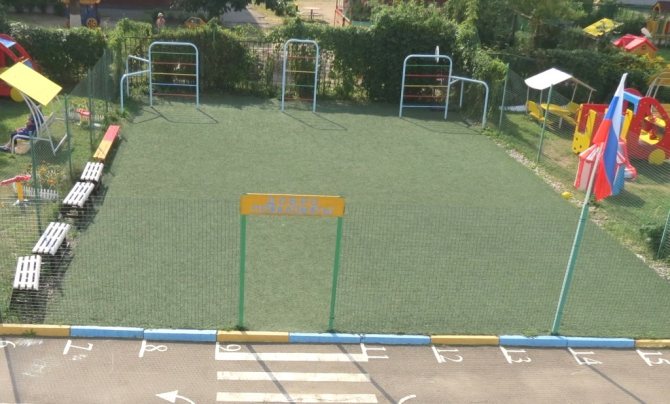
THE CENTER FOR ARTISTIC AND AESTHETIC DEVELOPMENT is filled with children's books, materials for creative activities and includes corners for theatrical activities and art activities, a music corner, and a book corner.
In the corner of the book, children look at them with interest, remember already familiar fairy tales, together with the teacher they learn new ones and even come up with their own literary works. The books are located in an accessible place, so children can be independent in choosing books.
The theatrical activity corner allows children to act out their favorite fairy tales and helps to identify and develop the child’s creative abilities. Toys and different types of theaters are located here: “bi-ba-bo”, flat table theater, finger theater, tantamaresca - everything for showing performances. Children, under the guidance of teachers, become familiar with the features of a theatrical puppet and master the skill of working with it. Various costumes hang in the cabinets, hats, masks and other theatrical attributes are on the shelves. While playing theater, children are united by an interesting idea and demonstrate unexpected facets of their character. Timid and shy people become confident and active.
The fine arts corner promotes creative self-expression, the development of fine motor skills, the formation of aesthetic taste, and the acquisition of drawing and sculpting skills in children. For these purposes, a variety of materials for fine arts are placed in the corner: stencils, paints, colored pencils, wax crayons, coloring books, white and colored paper, plasticine, cardboard, scissors. The corner is located in well-lit places in each group.
In the music corner, children enjoy playing the metallophone, drum, knocking on a tambourine, and turning a barrel organ. Here is a selection of discs and cassettes with audio recordings of children's songs and melodies that children love to listen to and sing along with. In the music corner there are card indexes of various nursery rhymes, finger games, pictures of various musical instruments, and portraits of composers.
THE CENTER FOR COGNITIVE AND SPEECH DEVELOPMENT includes corners of nature and experimentation, corners of sensory development and design, and a speech corner. In the senior and preparatory groups there are corners “My country - my Russia”.
In the corner of nature and experimentation, children get acquainted with indoor plants and learn basic ways to care for them. There are also models that give initial ideas about the parts of the day, days of the week, a weather calendar that helps children in mastering the phenomena of inanimate nature, natural material for the development of children's creativity, as well as some material for conducting experimental research activities (sand, clay, waste material , water containers). Children can experiment with safe materials using the file cabinet and experiment charts in the corner.
The sensory development corner is organized in junior and middle groups for children 3-4 and 4-5 years old. During these age periods, children develop ideas about the color, shape, and size of objects. The playing material, which is located in the corner, helps expand children's ideas about the shape, color, size, nature of the surface of objects, and also develops fine motor skills, memory, and attention.
The Construction Corner features various types of construction sets and cubes. The material is stored in specially designated places and, if desired, is used by children to create and play with various buildings. Next to the construction set there are cars and toys for playing with children's buildings. The constructor can be moved to any place in the group and organized activities, both with a subgroup of children and individually. The mobility of this corner allows children to develop the plot of the game outside of it, and this makes it possible to feel comfortable in the group space.
THE CENTER FOR SOCIO-COMMUNICATION DEVELOPMENT gives children the opportunity to express themselves in the leading activity - play. Role-playing game is the main companion of childhood. During this game, the child can show independence and activity, while at the same time interacting with other children. In the corner of the role-playing game there are all the necessary items and attributes for games such as: “Shop”, “Hospital”, “Barbershop”, “Family”, “School”, “Sea Voyage”.
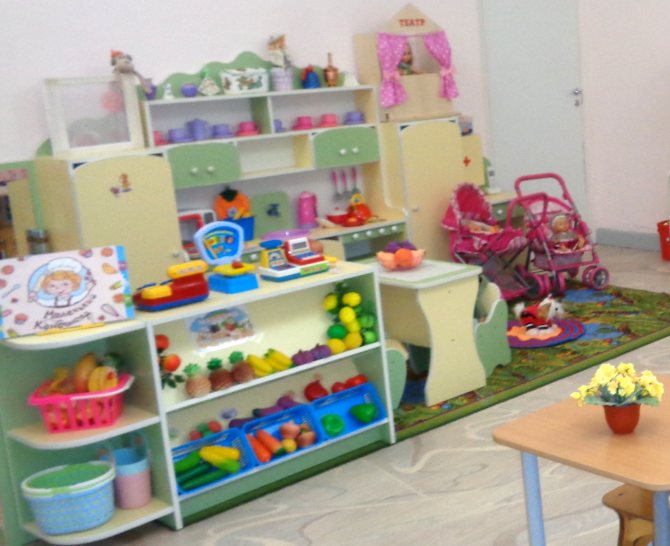
To organize the work activities of children in groups, there are algorithms for setting the table, proper hand washing, and dressing algorithms.
All toys and play material, according to the principle of accessibility , are placed at children’s eye level and at arm’s length so that children can freely play with them and put them away. For this purpose there are racks, cabinets, drawers, baskets, containers. Playing material and toys correspond to the age of children and the requirements of sanitary and epidemiological rules and regulations.
You can get acquainted with the developing subject-spatial environment created in each group in the “Our Groups” section.
The territory of the kindergarten is a variety of educational modules
Unique busy boards are placed on the territory of the kindergarten. With the help of these developmental boards, the child learns a variety of small movements - opening, pressing, twisting. Games with busy boards are multifunctional and allow you to solve several problems at the same time. Employees, children, and parents took part in the creation of business beards (ideas, sketches, production).
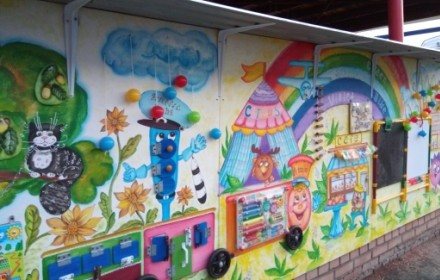
On the territory of the kindergarten there is another play complex - a music house. The equipment of the house includes a variety of musical instruments, the history of which children learn about the history and sound characteristics of them in class.
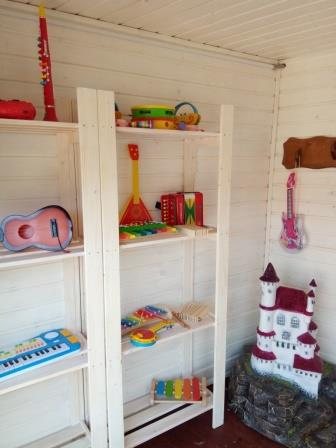
Story clearings
For the cognitive development of children, landscape compositions were created on the territory of the kindergarten: “Farm”, “Mill”, “Forest”, “Fairy Tale”. Each composition is an area with small sculptural forms. Here children get acquainted with the world of wildlife - wild and domestic animals and birds. Here you can also see the heroes of familiar fairy tales and remember their plot.
Project "EcoGrad"
We also have an experimental experimental site “EcoGrad”, which includes a greenhouse, a health path, flower beds, plantings of medicinal plants and all the green spaces on the territory.
Bell Museum
Since April 2003, there has been a Museum of Bells in the kindergarten. The collection of bells is constantly updated with new exhibits brought as gifts by children and parents, as well as our employees and guests from different cities and countries.
The museum currently has over 150 bells!
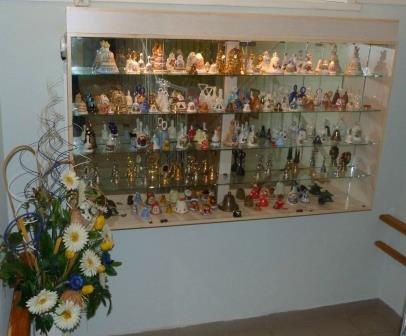
Project "Kindergarten - NaukoGrad"
In kindergarten, children learn the basics of robotics and programming with the help of programmable robots “Smart Bee” and “Robomouse” and the Matatalab robotics kit. They conduct research using the modern children's digital laboratory “Naurasha”. Using the moving Solar System model, the structure of the solar system is studied. Conduct research using a digital microscope and kits for scientific and educational experiments. They study construction technologies and 3D modeling using the eco-friendly craft construction set YOHOKUB (more details).
Information Center
There is an information stand in front of the main entrance to our kindergarten. Parents and all visitors who come to the kindergarten can always get information about planned events, get acquainted with the recommendations of experts and see footage from the life of children in the kindergarten.
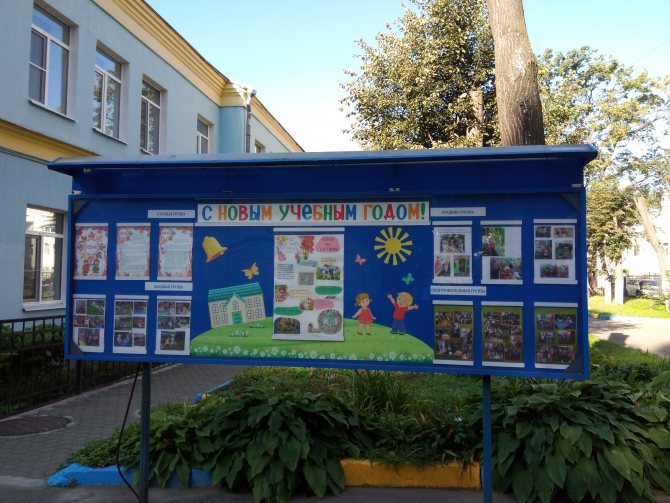
In the dressing room of each group there is also a stand with information: the group’s passport, daily routine, class schedules, announcements, consultations on current topics, tips and recommendations on the development and upbringing of children.
